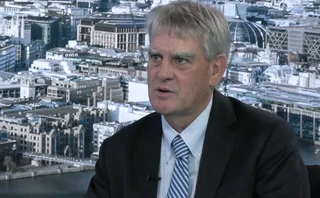
Exchange of the year: CME Group
Risk Awards 2021: Changes to options strikes helped CME avoid major mishaps in volatile 2020

Listening and responding to customer feedback is a good idea in any business. But for CME Group, a timely response in 2019 led to a special payoff: seemingly arcane changes to options strikes that clients had suggested stood the company in good stead to handle the extraordinary volatility caused by Covid-19.
Stock market volatility reached historic levels in March 2020 as the coronavirus rapidly spread around the world. In foreign exchange, prices also started to see-saw after two years of calm. Even US Treasuries were pulled into the vortex, with investors ditching the traditionally safe assets in exchange for cash and other unusual factors, such as remote working, playing havoc with the orderly functioning of markets.
But CME went into the turmoil prepared.
“CME didn’t have any issues through the crisis – which, to me, speaks volumes,” says one user of the exchange, a senior trader at a large asset manager. The client notes that the safeguards CME had introduced before 2020 to ensure orderly markets during big moves, such as circuit-breakers, “worked well”.
CME’s resilience has its roots in this kind of mundane task that the exchange performs behind the scenes and rarely seeks credit for.
One such task can be traced back to 2018. At that time, customers began complaining of inefficiencies in the bourse’s market-making rules for options products, says Derek Sammann, global head of commodities and options products at CME.
“We had some legacy rules in place that required our market-makers to be quoting all strikes all the time, in all time zones,” he says.
That meant market-makers had to provide quotes on a vast number of deep out-of-the-money strikes on 100-delta options that traded at the money, says Sammann. As a result, a large share of messaging bandwidth on Globex – CME’s electronic trading system for futures and options – was used up by quotes that were too unattractive for anyone to trade on.
CME realised that not only a “huge” number of strikes were not being taken up by market participants, but that such unnecessary messaging traffic could cause problems in periods of high volatility and high volumes, Sammann says.
CME didn’t have any issues through the crisis – which, to me, speaks volumes
Senior trader at a large asset manager
Sean Tully, global head of financial and over-the-counter products at CME, explains: “Message capacity is our biggest constraint, and it’s been CME’s policy for many years to ensure that we have a message capacity that is multiples of our previous peak.”
In the first quarter of 2020, options messaging traffic was three-and-a-half times the average traffic in 2019, he says. Fortunately, CME had taken steps to reduce the number of strikes available to exchange participants across equities, FX and rates, with the bulk of the cuts made in 2019.
That is not to say the firm sacrificed customer choice, Tully notes, as it only excised the strikes that demonstrably went unused by members of the exchange. CME also expanded its hardware capacity in 2019 to support greater messaging traffic in options.
As Tully says, even with a significant share of strikes eliminated, messaging traffic on CME was extremely high in early 2020. But thanks to the cuts, it was manageable. Compared with October 2018, when options messaging traffic had last peaked, in March 2020, options volumes on Globex jumped by 37% to just over 98 million contracts – but corresponding messaging traffic increased by just 15%.
This helped CME avoid the kind of high-profile wobbles that afflicted other exchanges last year – such as, for instance, outages at Deutsche Börse’s electronic trading platform Xetra.
Sammann says the changes to the strike rules have also informed CME’s thinking on new products, helping the exchange decide on the optimal number of strikes to roll out.

CME’s work on circuit-breakers is another example of measures it implemented in peacetime that have won recognition from clients. One client, the buy-side trader, says the bourse made good use of the measure during the crisis, to halt trading when indexes were shedding several percentage points in a matter of minutes.
Another client, a managing director at one of the larger CME members, praises the exchange for its responsiveness during the Covid-19 market mayhem – specifically, for providing, on request, numerous metrics of liquidity.
“We have good lines of communication and good dialogue with CME. I can reach out at any point and I get a pretty prompt response,” the client says.
“Overall … we were able to get our risk hedges done, even in the worst of times during the pandemic period.”
The bourse also moved quickly during the crisis to support its exchange participants in another, more personal way. As traders left offices and began to work from home, CME migrated more than 200 such clients from its EBS Workstation, a proprietary platform for FX trading, to a web-based service designed for home use.
“A lot of those participants wanted that EBS Workstation keyboard, and they couldn’t go to their offices to get them,” Tully says.
“So, we ordered dozens – and, in some cases, our salespeople literally got in the car and drove them to our customers’ homes.”
Despite tough market conditions in 2020, CME managed to launch a wide range of new products throughout the year, including additions to its existing suites of bitcoin futures and options, Sonia futures and physical liquified natural gas futures. And in the depths of the market meltdown in March, the bourse introduced a new product when clients most needed it.
When Covid-19 lockdowns closed the European gold smelting industry almost overnight without warning, customers feared they would be unable to ship bullion from London to satisfy physical delivery of existing Comex gold futures in New York. London accepts 400-ounce bars, which have traditionally had to be melted down and recast as 100-ounce bars for CME’s Comex exchange. The disruption from lockdowns led to a dislocation between spot and futures prices, so, in a bid to restore normality, CME launched a new gold futures contract that offers a choice of delivery sizes, including 400-ounce bars.
Only users who have a paid subscription or are part of a corporate subscription are able to print or copy content.
To access these options, along with all other subscription benefits, please contact info@risk.net or view our subscription options here: http://subscriptions.risk.net/subscribe
You are currently unable to print this content. Please contact info@risk.net to find out more.
You are currently unable to copy this content. Please contact info@risk.net to find out more.
Copyright Infopro Digital Limited. All rights reserved.
As outlined in our terms and conditions, https://www.infopro-digital.com/terms-and-conditions/subscriptions/ (point 2.4), printing is limited to a single copy.
If you would like to purchase additional rights please email info@risk.net
Copyright Infopro Digital Limited. All rights reserved.
You may share this content using our article tools. As outlined in our terms and conditions, https://www.infopro-digital.com/terms-and-conditions/subscriptions/ (clause 2.4), an Authorised User may only make one copy of the materials for their own personal use. You must also comply with the restrictions in clause 2.5.
If you would like to purchase additional rights please email info@risk.net
More on Awards
Collateral management and optimisation product of the year: CloudMargin
Delivering the modern blueprint for enterprise collateral resilience
Flow market-maker of the year: Citadel Securities
Risk Awards 2026: No financing; no long-dated swaps? “No distractions,” says Esposito
Pricing and analytics: fixed income – Quantifi
Quantifi delivers high-performance, transparent and adaptable pricing and risk analytics for fixed income and credit markets
Derivatives house of the year: Citi
Risk Awards 2026: Rev up, RWAs down, as US bank gets back on track (with added XiNG and XiP)
Technology vendor of the year: SS&C Algorithmics
Risk Awards 2026: From cloud, to chips, to maths tricks – vendor getting more out of existing tech
SS&C Algorithmics: winner’s interview with Curt Burmeister
SS&C Algorithmics wins three categories in this year’s Markets Technology Awards in addition to Technology vendor of the year at the Risk Awards
Best vendor for system support and implementation: Murex
Murex wins Best vendor for system support and implementation at the Markets Technology Awards 2026
Pricing and analytics: cross-asset and structured – Murex
Murex wins Pricing and analytics: cross-asset and structured at the Markets Technology Awards 2026 thanks to its MX.3 platform







